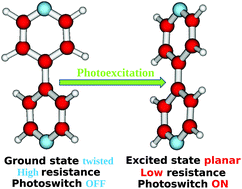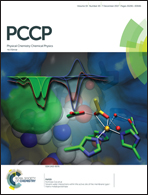Floppy molecules as candidates for achieving optoelectronic molecular devices without skeletal rearrangement or bond breaking†
Abstract
Molecular species investigated as possible candidates for molecular photoswitches often toggle between two (low and high conductance) conformations implying skeletal rearrangement, bond breaking, and substantial changes of molecular length. All these represent shortcomings that impede the switching speed and straightforward incorporation in nanodevices. In the present paper we propose a mechanism wherein the photoinduced switching is from a nonplanar conformation to a planar conformation, and involves neither skeletal rearrangement nor bond breaking or significant molecular length changes. Specifically, by choosing typical floppy molecules consisting of two benzene or benzene-like rings that can easily rotate relative to each other, we present results of both ab initio and DFT quantum chemical calculations demonstrating that the lowest electronic excitation corresponds to a planar molecular conformation (φ = 0), in contrast to the nonplanar ground state characterized by φ ≠ 0. Because the low bias conductance scales as G ∝ cos2 φ, the planar conformation has a higher conductance than the non-planar conformation, acting therefore as ON and OFF states of the molecular switch, respectively. We analyze recent experimental data on illuminated single-molecule junctions (E.-D. Fung et al., Nano Lett., 2017, 17, 1255) and show that the measured photoinduced conductance enhancement is consistent with the presently proposed mechanism. Furthermore, based on recent results demonstrating the substantial impact of the SAM coverage on the twisting angle (I. Bâldea, Faraday Discuss., 2017, 204, 35) we show that a photoinduced conductance enhancement can be much stronger than the rather modest enhancement obtained in the aforementioned experiment.



 Please wait while we load your content...
Please wait while we load your content...